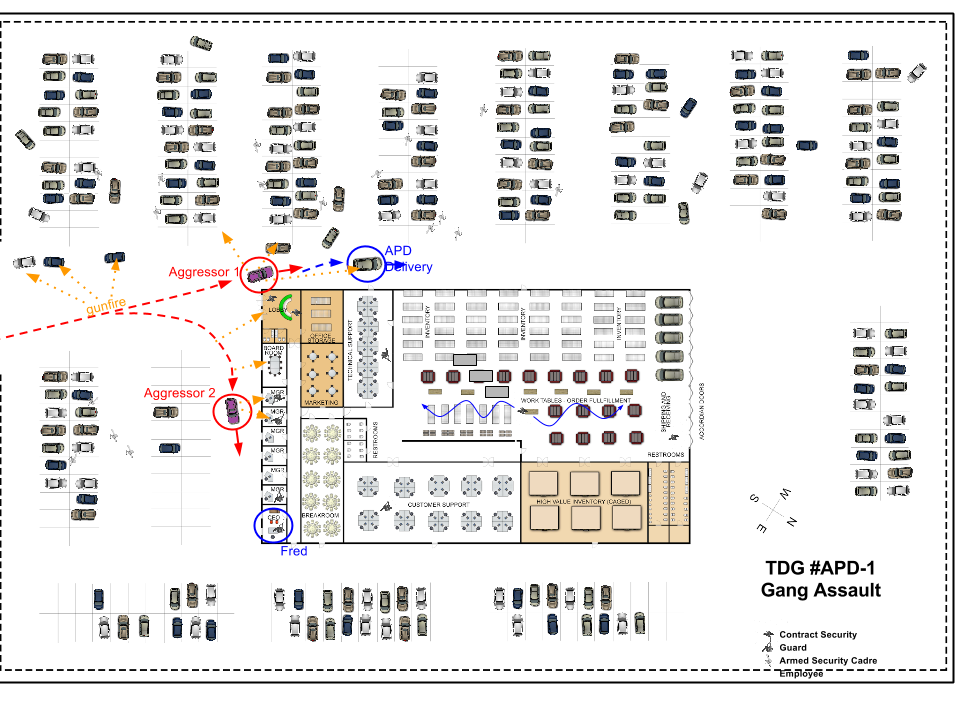Article Index
TDG #APD-1: Gang assault.
You are Fred Schmitt, CEO of Auto Parts Distributors, in your office. It is 3:10pm Wednesday in Detroit. APD’s plant shift ended ten minutes ago and upwards of 150 workers are heading for home. At this moment, the building is still crowded, many workers are on foot in the parking lot, and some cars are already pulling out of the parking area and stacking up at the exit onto the street.
EXHIBIT 6.1 APD Gang assault.

Background: Your new security organization is not yet fully developed. Four contract security guards (armed with handguns) are, as usual, in the building – at this time of day, you would expect two to be in the front lobby, one by the accordion doors in Shipping/Receiving, and the supervisor roaming through the building. Your security cadre at this time consists of five managerial employees besides yourself who have trained for security response and have carbines or shotguns and associated kit in secure lockers in their workspace; drills have proven that retrieving gear and making ready takes about 30 seconds for a cadre member within a few steps of his locker.
Two minutes ago Floyd, your VP for operations, called you in your office to report that the last of your delivery vans, returning to the plant, called via cell phone to report that a group of young men loitering at an intersection on their route ran into the street, attempted to stop them, shouted and flashed gang signs, and then piled into two cars parked at the curb and are now following the van.
Now, over the usual level of noise at the end of a plant shift, you hear the screeching of tires from the direction of the gate opening onto the street in front of the building. You see your delivery van entering the lot at a high rate of speed – the right side tires are almost off the ground as it makes the turn into the lot – but before you can turn to pick up the handset, two SUVs follow the delivery van through the gate and all hell breaks loose.
You hear the pop-pop-pop of gunfire, some of it with the louder and sharper report of rifle-caliber rounds. You see the windows are down on both SUVs, muzzles extending out the passenger-side windows, and muzzle flashes on the driver’s side, as shots are fired into the vehicle and pedestrian traffic in the SW corner of the parking lot. The delivery van disappears from your view around the front corner of the building, with one of the SUVs in close pursuit – you see a shooter leaning out of the window and firing ahead, presumably toward the delivery van in front. The second SUV slews to the right and heads down the front of the building, towards you. You see a short muzzle extending out the rear driver’s side window, and short bursts of automatic fire into the lobby, board room and first managerial offices are accompanied by the sounds of breaking glass and screaming.
What do you do now, Fred, both personally in the next few seconds and via communications and direction to your employees?
By developing specific scenarios based upon situations your team or unit might face, and working them with your own team, you can learn how your teammates think and respond in a tactical situation. This knowledge will help you work together in the event of a real-life emergency.
You can also use TDG’s to accomplish a quick test or ‘reality check’ of plans and tactical concepts. Because they portray only a snapshot in time – a single decision point - they are not strong analytical tools but they can point out gaps or weaknesses in your system or your training.




